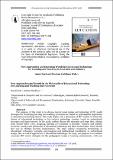DSpace Repository
A Computer Experiment Model to Investigate the Effects of Drug Dosage in Animals, for Use in Pharmacological Education and Research
- DSpace Home
- →
- Web Of Science
- →
- Web Of Science
- →
- View Item
JavaScript is disabled for your browser. Some features of this site may not work without it.
| dc.contributor.author | Ipek, Ismail
|
|
| dc.date.accessioned | 2024-03-25T08:02:08Z | |
| dc.date.available | 2024-03-25T08:02:08Z | |
| dc.date.issued | 2011 | |
| dc.identifier.issn | 0261-1929 | |
| dc.identifier.uri | http://hdl.handle.net/11547/11410 | |
| dc.description.abstract | The purpose of this study is to discuss instructional design and technology (IDT) model strategies for developing learning and teaching environments, based on philosophical approaches to educational technology theory. The study begins with a discussion of IDT models to define the history of educational technology or instructional technology theories, based on instructional strategies and improvements. In the study, authors discuss the strategies and steps that a design team should follow when designing learning environments in industry, business and military scenarios, based on the philosophy of educational technology and latest technologies, which should give way to effective learning environments. The steps include recognizing terminology in educational technology concepts, psychological and instructional foundations in instructional design (ID), as well as approaches to educational technology. To recap, our purpose is to combine necessary IDT model strategies for the pedagogical design of learning environments, with new technologies. We will also discuss powerful IDT models that aim to meet the very high expectations of digital and humanist education. To develop a high-quality learning environment, we will explain technology design steps and practice in order to improve the learning of tasks, complex cognitive skills, attitudes, motivations and competencies in the future trends of educational technology. At the end of the study, integrated technologies in e-learning were discussed and presented, based on foundations of IDT and the philosophy of educational technology. These included pedagogical, technological and organisational technologies, as well as the main barriers of implementation, which, in turn, include the perspectives of students, teachers and designers, learning materials, digital education, epistemology in educational technology, courseware design, new technologies and contextual settings. | tr_TR |
| dc.language.iso | en | tr_TR |
| dc.relation.ispartofseries | 39;6 | |
| dc.title | A Computer Experiment Model to Investigate the Effects of Drug Dosage in Animals, for Use in Pharmacological Education and Research | tr_TR |
| dc.type | Article | tr_TR |
Files in this item
This item appears in the following Collection(s)
-
Web Of Science [970]
